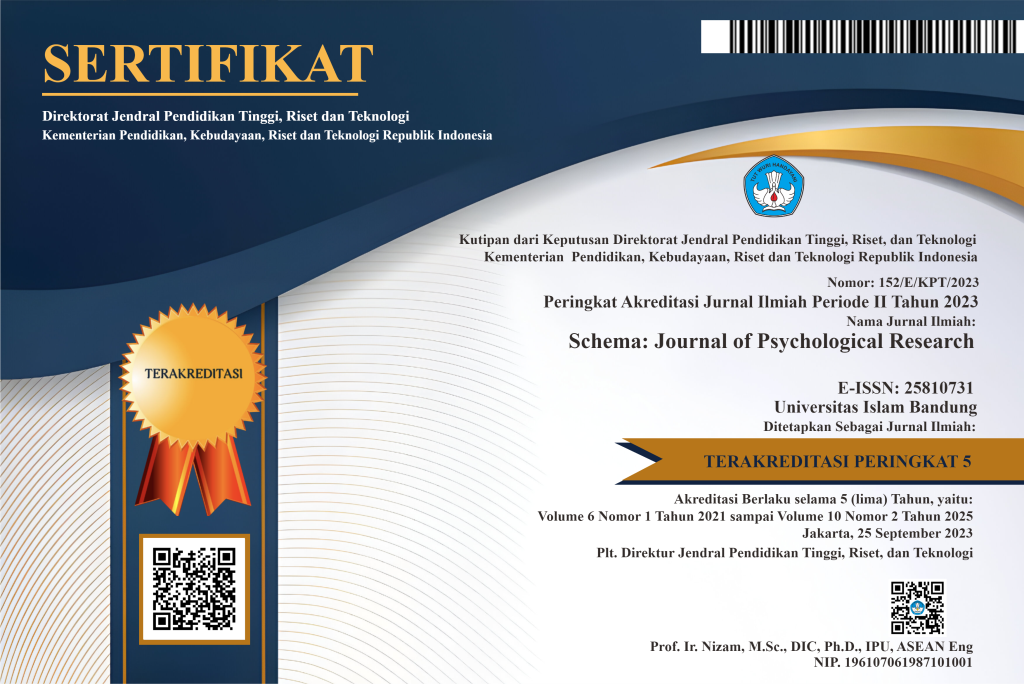KELEKATAN IBU DAN BAYI PASCAMELAHIRKAN PADA IBU YANG BEKERJA DITINJAU DARI MATERNAL SENSITIVITY
Abstract
Attachment is one of the important aspects in children’s development. However, there were some issues related with the condition of being working mothers. Based on that, the purpose of this study was to examine the relationship between the maternal sensitivity and the postnatal attachment. Respondents in the study is a working mother who have infants (0-24 months) and the number were 100 mothers. The hypothesis of this study assumed that there was a positive correlation between maternal sensitivity to postnatal attachment among working mothers. The instruments of this study were consisted of the Maternal Postnatal Attachment Scale (MPAS) (Condon & Corkindale, 1998) and Maternal Sensitivity Scale compiled by researchers in establishing maternal sensitivity aspect of Ainsworth (1969; 2006). The results showed that the research hypothesis was accepted, that was indicated with significant correlation between maternal sensitivity and postnatal attachment (r = 0.596; p = 0.000). This finding will be discussed further in this paper.
Full Text:
PDF (Bahasa Indonesia)References
Apollo, & Cahyadi, A. (2012). Konflik peran ganda perempuan menikah yang bekerja ditinjau dari dukungan sosial keluarga dan penyesuaian diri. Widya Warta, 02, 254-271.
Ash-Shabuni, B. (2007). Muslimah juara. Solo : Aqwam Media Profetika.
Cremona, S. (2008). Antenatal predictors of maternal bonding for adolescent mothers. Thesis (Tidak diterbitkan). Victoria University.
Hasyimi, M. A. (2012). Syakhshiyatul mar’ah al-muslimah membentuk pribadi muslimah ideal menurut al qur’an dan as sunnah. Jakarta : Al-I’tishom.
Karina, R., & Mulyati, R. (2007). peran ayah dalam pengasuhan dan kelekatan remaja pada ayah. Naskah Publikasi. Yogyakarta : Program Studi Psikologi Fakultas Psikologi dan Ilmu Sosial Budaya Universitas Islam Indonesia.
King K. L., Priddis L. E., & Kane R. T. (2014). Enhancing maternal sensitivity and emotional wellbeing through a preventative parent–child relationship intervention in a community setting. J Child Fam Stud. Springer Science Business Media New York.
McElwain. NL., &LaForce. C. B. (2006). Maternal sensitivity to infant distress and nondistress as predictors of infant–mother attachment security. Journal of Family Psychology, 20(2), 247-255.
Moran, G., Forbes. L. M., Evans, E., Tarabulsy, G. M., & Madigan, S. (2008). Both maternal sensitivity and atypical maternal behavior independently predict attachment security and disorganization in adolescent mother–infant dyads. Psychology Presentation. Paper 19.
Noordiati., Hakim M., & Wibowo T. (2011). Hubungan kepekaan serta ketanggapan pengasuhan ibu terhadap perkembangan anak prasekolah. Berita Kedokteran Masyarakat, 27(1), 18-23.
Papalia, D.E., Old, S.W., & Feldman, R.D. (2008). Human development (psikologi perkembangan). Jakarta : Kencana.
Santrock J. W. (2007). Perkembangan anak edisi kesebelas jilid 2. Jakarta : Erlangga.
Utami, R. E. R., Paraswati, DM. (2012). Peranan pengasuh anak (baby sitter) dalam pembentukan sifat dan sikap anak (studi di perumahan bukit bakung indah bandar lampung. Jurnal Sociologie, 1 (2), 144-155
Velderman. M. K., Bakermans-Kranenburg. M. J., Juffer, F., & van Ijzendoorn, M. H. (2006). Effects of attachment-based interventions on maternal sensitivity and infant attachment: differential susceptibility of highly reactive infants. Journal of Family Psychology, 20 (2), 266-274.
DOI: https://doi.org/10.29313/schema.v0i0.3781
Refbacks
- There are currently no refbacks.
Indexed by:
This work is licensed under a Creative Commons Attribution-NonCommercial-ShareAlike 4.0 International License.












